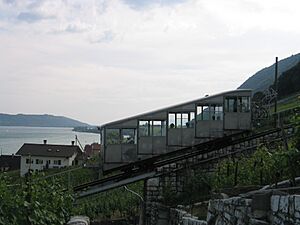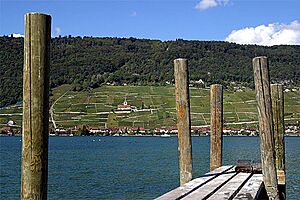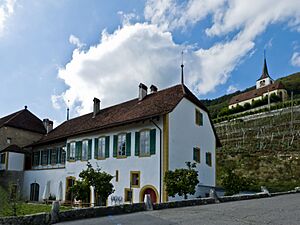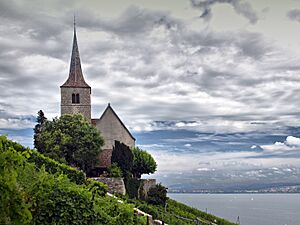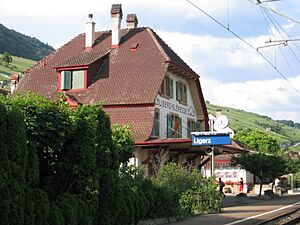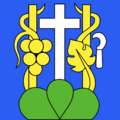Ligerz facts for kids
Quick facts for kids
Ligerz
|
||
|---|---|---|
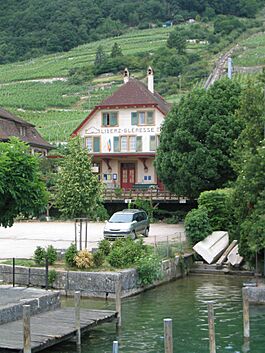
Ligerz
|
||
|
||
| Country | Switzerland | |
| Canton | Bern | |
| District | Biel/Bienne | |
| Area | ||
| • Total | 1.79 km2 (0.69 sq mi) | |
| Elevation | 433 m (1,421 ft) | |
| Population
(Dec 2020 )
|
||
| • Total | 545 | |
| • Density | 304.5/km2 (788.6/sq mi) | |
| Postal code |
2514
|
|
| Surrounded by | Lamboing, Twann, La Neuveville, Prêles | |
| Twin towns | Erôme (France) | |
Ligerz (called Gléresse in French) is a small town, also known as a municipality, in Switzerland. It is located in the Biel/Bienne area of the canton of Bern. Ligerz sits right on the northern shore of Lake Biel, making it a beautiful place to visit.
Contents
History of Ligerz

Ligerz was first mentioned in old records way back in 1236. People have lived around Lake Biel for a very long time! Scientists have found signs of settlements from the neolithic period (the New Stone Age) near Ligerz. They also found items from the Bronze Age and the Roman era.
Who Ruled Ligerz?
During the Middle Ages, Ligerz was controlled by local lords, the "Lords of Ligerz." Their castle, called the Festi, was first written about in 1236. Over time, parts of Ligerz were sold or given to the city of Biel and the canton of Bern. By 1551, Bern owned all of Ligerz. In 1553, Bern made sure the people of Ligerz could keep their old rights to have markets and to fish.
The Village Church
The church in Ligerz, which was a place for pilgrimage (a special religious journey), was first mentioned in 1261. It was built among the vineyards above the village. It became its own parish church (the main church for a local area) in 1434. The church was rebuilt between 1520 and 1526.
Vineyards and Language
For centuries, the hills above Ligerz have been covered with vineyards. Many different towns and monasteries owned these vineyards. Later, wealthy families from Bern and Biel bought them. These families built fancy houses in Ligerz, where they would stay during the grape harvest.
Until the 18th century, most people in Ligerz spoke French. The village school even taught in both French and German. But today, German is the main language spoken in Ligerz.
Modern Connections
For a long time, the only good way to reach Ligerz was by boat. But in the 1830s, a road was built connecting Ligerz to the city of Biel. Then, in the 1850s, a railroad was built, linking Ligerz to the rest of the country. In 1911-1912, the Ligerz-Tessenberg funicular (a special cable car) was built, making it easier to travel up into the mountains.
Because Ligerz has very little flat land, a special tunnel was built between 1984 and 1991 for the motorway. This helped keep the village looking beautiful and untouched. Today, Ligerz is known for its wine, tourism, and fishing.
Geography
Ligerz covers an area of about 1.8 square kilometers (0.7 square miles). A large part of this land, about 50.6%, is covered by forests. About 31.7% is used for farming, especially for vineyards. The rest of the land is used for buildings, roads, or is covered by lakes and rivers.
The town is located in the Bernese Seeland region, right on the northern shore of Lake Biel. It includes the main village of Ligerz and smaller areas called hamlets, such as Bipschal and part of Kleintwann. There are also hamlets like Schernelz and Festi located higher up on a terrace in the Jura Mountains.
Coat of Arms
The blazon (description) of Ligerz's coat of arms shows a blue shield with a silver cross. This cross rises from three green hills. On either side of the cross are two golden grapevines, one with grapes and one with leaves. In the bottom left, there's a silver sickle (a tool used for cutting).
Population and People
Ligerz has a population of about 519 people (as of December 2011). Most people in Ligerz speak German as their first language (about 90%). A smaller number speak French (about 6%), and a few speak English or Italian.
In 2011, about 17% of the population were children and teenagers (0-19 years old). About 58.8% were adults (20-64 years old), and 24.3% were seniors (over 64 years old).
Most people in Ligerz are married, but there are also single, widowed, and divorced individuals. The town has a mix of different household sizes, from people living alone to larger families.
Population Changes Over Time
The number of people living in Ligerz has changed over the years. Here's a look at the historical population:

Important Heritage Sites
Ligerz has some very important historical buildings. The Aarberger House (at Hauptstrasse 19), the Gaberel House Nr. 53 (at Dorfgasse 20), and the village church are all listed as Swiss heritage sites of national importance. This means they are very special and protected. The entire village of Ligerz and the small area of Bipschal are also part of the Inventory of Swiss Heritage Sites.
Economy and Jobs
Ligerz has a low unemployment rate, meaning most people who want to work can find jobs. In 2008, there were 192 people working in the town.
Main Job Areas
- Primary Sector: This includes jobs related to natural resources, like farming and fishing. In Ligerz, many people work in vineyards.
- Secondary Sector: This involves making things, like manufacturing and construction.
- Tertiary Sector: This is the service industry, such as hotels, restaurants, shops, and transportation. Tourism is important in Ligerz because of its beautiful location.
Many people who live in Ligerz also work there. For those who work outside the town, most use a private car to get to their jobs, while some use public transportation.
Religion
Based on a 2000 survey, most people in Ligerz (about 72.7%) belong to the Swiss Reformed Church. About 11.2% are Roman Catholic. A small number of people belong to other Christian churches or are Islamic. About 12% of the population do not belong to any church, or are agnostic or atheist.
Education
Many adults in Ligerz have completed higher education. About 55.7% have finished upper secondary education (like high school), and 34.4% have gone on to university or a specialized college.
In 2000, there were a few students who lived and went to school in Ligerz. However, many students from Ligerz traveled to schools in other towns.
Transportation
Ligerz is well-connected for a small town. It has its own train station, making it easy to travel by rail. There's also a harbor for the Bielersee Schiffahrt Gesellschaft AG (Lake Biel ship travel company), so you can explore the lake by boat. And don't forget the funicular (cable car) that takes you up to the town of Prêles in the mountains!
Images for kids
See also
 In Spanish: Ligerz para niños
In Spanish: Ligerz para niños





